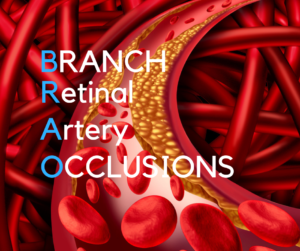Branch Artery Occlusion (BRAO)


4 Types of Retinal vascular occlusions (RVO)
- BRVO = Branch retinal vein occlusion
- CRVO = Central retinal vein occlusion
- BRAO = Branch retinal artery occlusion
- CRAO = Central retinal artery occlusion
Symptoms of BRAO
As with all retinal vascular occlusions, patients experience sudden painless loss of vision. Compared to a “central” artery occlusion where the entire retina is involved, patients with a branch occlusion do not lose as much vision. Central vision is lost if the macula is involved.
Vision loss is usually permanent.
Causes of Artery Occlusions
All retinal artery occlusions are caused by an embolus. An embolus is an “object” which travels through the bloodstream and gets stuck in an artery causing a blockage or occlusion. An embolus can be composed of fat, cholesterol, blood clot or other substance.
The most common type of embolus is made of cholesterol and is called a Hollenhorst plaque.
Artery occlusions in the brain cause stroke. Similarly, artery occlusions in the heart cause heart attacks.
Treatment of BRAO
There is no known treatment for BRAO. If caught early, there may be an attempt to dislodge the embolus and move it “downstream,” but these methods are usually unsuccessful.
Treatment may be targeted to reducing any macular edema, if present. Anti-VEGF medications may be utilized as well as laser, but in general, vision loss does not improve as with branch retinal vein occlusions
As with any RVO, there is a risk of developing neovascular glaucoma. Early detection to prevent neovascular glaucoma from developing may require frequent visits even though vision is not changing.
Systemic evaluation for stroke/heart attack prevention is warranted.


